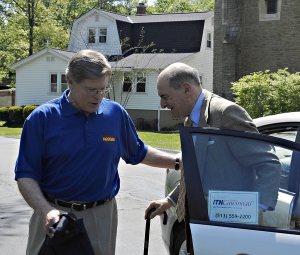By Tom Peterson
In 1988, Katherine Freund was set on a new path. That’s when an 84-year-old driver, who should not have been behind the wheel, hit her 3-year old son. The son survived the life-threatening brain injury, is healthy and now in his thirties. But the event led Freund, then working on graduate studies in public policy, to explore this question: what options do seniors have as they lose their ability to drive?
It’s been said that when “I” is replaced with “we,” illness becomes wellness. This is certainly true for elderly people as they seek help getting to vital medical appointments. In the United States seniors typically outlive their ability drive—seven years for men and a decade for women. And this has a big impact on their health.
Millions of missed medical appointments
 “About 3.6 million Americans miss or delay medical appointments every year because they lack a ride to the doctor,” writes Therese McMillan for the U.S. Department of Transportation. “Given that America’s population is aging, and about half of us live with at least one chronic condition, getting regular health care is more important than ever.”
“About 3.6 million Americans miss or delay medical appointments every year because they lack a ride to the doctor,” writes Therese McMillan for the U.S. Department of Transportation. “Given that America’s population is aging, and about half of us live with at least one chronic condition, getting regular health care is more important than ever.”
Freund’s studies after her son’s accident ultimately led to found Independent Transportation Network, or ITN. In 1995 in her hometown of Portland, Maine, ITN provided its first ride.
For seniors who are not comfortable driving, especially at night, or who can no longer drive, such a trip can be a lifeline. Residents where ITN operates join the organization and can schedule trips 24 hours a day. Drivers even come to the door to help the passenger into and out of the car. Seniors use ITN to get to medical appointments, go grocery shopping, attend religious services or go almost anywhere.
ITN coast-to-coast
Today the nonprofit ITN is made up of affiliates in 27 communities across the country, from San Diego to Boston. They offer volunteer-based transportation in personal cars “for hundreds of thousands of older and vision-impaired people.” Service in another dozen cities is in the works. You can see where they operate here.
While no cash changes hands at the time of the ride, ITN offers a variety of innovative ways to pay. For example, “Drivers can donate miles to their own account for future use or donate to others. Families can pay into the account of a senior family member.”
Here’s another video from the ITN Storybook Tour, celebrating 20 years of rides: “Shephard Eugene L. Milligan of Memphis finds “God’s blessing” in the transportation service that ITNMemphis has brought to him and others who cannot get around on their own. Before he found ITNMemphis, he experienced much difficulty with spotty access to transportation services in the area.”
Here are a few facts from the ITNAmerica website:
- Seniors may trade in their vehicle for ride credits.
-
Volunteers may earn ride credits by volunteering to drive. These credits may then be used for transportation service at any of our affiliates or they may be donated to the Road Scholarship Fund for lower income riders.
-
Rides are available 24 hours a day, 7 days a week, for any purpose.
-
46 percent of ITN customers have an annual income of less than $25,000. Only 2 percent of ITN customers found the service too expensive.
-
94 percent of customers are “very satisfied” with the service they receive, with the people at ITN, and would recommend ITN to a friend.
-
49 percent of ITN riders retain a drivers license.
-
28 percent of ITN members still drive on occasion.
Photo: ITNAmerica. This article first appeared in Stakeholder Health.

No comments yet.